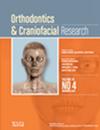Three-Dimensional Comparative Analysis of Root Parallelism in First Premolar Extraction Cases: Clear Aligner Versus Fixed Orthodontic Appliance
Abstract
Objective
To compare the three-dimensional root parallelism (mesiodistally and buccolingually) between orthodontic therapy with the Invisalign clear aligners (CA) and fixed appliances (FA) among the first premolar-extraction patients, using cone-beam computed tomography (CBCT).
Materials and Methods
Sixty participants with similar American Board of Orthodontics discrepancy index scores as baseline characteristics were included and divided into CA and FA groups (30 per group). Post-treatment mesiodistal and buccolingual root parallelisms were analysed through CBCT using Invivo 6.0.3 software. Descriptive and analytical statistics were performed with a p < 0.05, considered statistically significant.
Results
Mesiodistal dental root parallelism in the U1-U2 and L1-L2 pairings between CA and FA groups were found to be significantly different with inferior parallelism in the CA group (p < 0.05). Conversely, the U3-U5 and L5-L6 pairings exhibited superior parallelism in the CA group (p < 0.05). However, other pairings, including U1-U1, U2-U3, U5-U6, U6-U7, L1-L1, L2-L3, L3-L5, and L6-L7, showed no significant differences in mesiodistal parallelism between groups (p > 0.05). Regarding the buccolingual dental root parallelism, significant differences were also noted in the U5-U6 and L5-L6 pairings with superior parallelism in the CA group (p < 0.05). However, in the U1-U1, U2-U3, U3-U5, U6-U7, L1-L1, L2-L3, L3-L5, and L6-L7 pairings, no significant differences in buccolingual parallelism were observed (p > 0.05).
Conclusion
In this study, our findings indicate that in cases involving the extraction of first premolars, Invisalign clear aligners may offer comparable or even superior three-dimensional root parallelism compared to fixed orthodontic appliances, with the exception of the mesiodistal dimension in upper and lower incisors, where their performance is less effective.

 求助内容:
求助内容: 应助结果提醒方式:
应助结果提醒方式:


